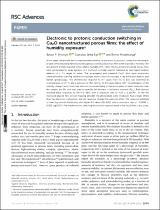 ResearchSpace
ResearchSpace
Electronic to protonic conduction switching in Cu2O nanostructured porous films: the effect of humidity exposure
JavaScript is disabled for your browser. Some features of this site may not work without it.
- ResearchSpace
- →
- Research Publications/Outputs
- →
- Journal Articles
- →
- View Item
| dc.contributor.author |
Dhonge, BP

|
|
| dc.contributor.author |
Ray, Suprakas S

|
|
| dc.contributor.author |
Mwakikunga, Bonex W

|
|
| dc.date.accessioned | 2018-11-27T11:53:23Z | |
| dc.date.available | 2018-11-27T11:53:23Z | |
| dc.date.issued | 2017-04 | |
| dc.identifier.citation | Dhonge, B.P. et al. 2017. Electronic to protonic conduction switching in Cu2O nanostructured porous films: the effect of humidity exposure. RSC Advances, vol. 7: 21703-21712 | en_US |
| dc.identifier.issn | 2046-2069 | |
| dc.identifier.uri | https://pubs.rsc.org/en/content/articlelanding/2017/ra/c7ra00383h#!divAbstract | |
| dc.identifier.uri | DOI:10.1039/C7RA00383H | |
| dc.identifier.uri | http://hdl.handle.net/10204/10545 | |
| dc.description | Open access article published in RSC Advances, vol. 7: 21703-21712 | en_US |
| dc.description.abstract | In this paper, we present the first experimental evidence for electronic to protonic conduction switching in p-type semiconducting nanostructured cuprous oxide Cu2O porous films when exposed to humidity. We also present a linear response at low relative humidity (RH < 48%). The Cu2O nanostructured porous films were synthesized by spray pyrolysis of a Cu/Cu2O colloidal solution obtained by laser liquid medium ablation of a Cu target in water. The as-prepared and annealed Cu2O films were extensively characterized by scanning electron microscopy, atomic force microscopy, X-ray diffraction analysis, and Raman spectroscopy. The chemiresistor response to RH values from 7.5 to 84% was examined at a temperature of 22 degrees C and a pressure of 760 mmHg. At RH values below 48%, recombination of the majority charge carrier holes and electrons occurred owing to the dissociation of water molecules near the surface; the RH level was used to quantify the increase in resistance response (R(sub)Res). Both devices revealed linear responses to RH (7.5–48%), with a maximum rate of 4.38 (plusminus) 0.16%/RH. As the RH increased beyond 48%, proton hopping between the physisorbed water molecules had a larger effect than the electronic conduction, and the response showed the opposite effect. The response exhibited a linear log-normal relationship with higher RH values (56–84%), with a maximum rate of -0.0694 (plusminus) 0.002 log(%)/RH. The mechanism for switching the resistive response trend of the Cu2O films is discussed. | en_US |
| dc.language.iso | en | en_US |
| dc.publisher | The Royal Society of Chemistry | en_US |
| dc.relation.ispartofseries | Worklist;21413 | |
| dc.subject | Cu2O nanostructured porous films | en_US |
| dc.subject | Humidity exposure | en_US |
| dc.title | Electronic to protonic conduction switching in Cu2O nanostructured porous films: the effect of humidity exposure | en_US |
| dc.type | Article | en_US |
| dc.identifier.apacitation | Dhonge, B., Ray, S. S., & Mwakikunga, B. W. (2017). Electronic to protonic conduction switching in Cu2O nanostructured porous films: the effect of humidity exposure. http://hdl.handle.net/10204/10545 | en_ZA |
| dc.identifier.chicagocitation | Dhonge, BP, Suprakas S Ray, and Bonex W Mwakikunga "Electronic to protonic conduction switching in Cu2O nanostructured porous films: the effect of humidity exposure." (2017) http://hdl.handle.net/10204/10545 | en_ZA |
| dc.identifier.vancouvercitation | Dhonge B, Ray SS, Mwakikunga BW. Electronic to protonic conduction switching in Cu2O nanostructured porous films: the effect of humidity exposure. 2017; http://hdl.handle.net/10204/10545. | en_ZA |
| dc.identifier.ris | TY - Article AU - Dhonge, BP AU - Ray, Suprakas S AU - Mwakikunga, Bonex W AB - In this paper, we present the first experimental evidence for electronic to protonic conduction switching in p-type semiconducting nanostructured cuprous oxide Cu2O porous films when exposed to humidity. We also present a linear response at low relative humidity (RH < 48%). The Cu2O nanostructured porous films were synthesized by spray pyrolysis of a Cu/Cu2O colloidal solution obtained by laser liquid medium ablation of a Cu target in water. The as-prepared and annealed Cu2O films were extensively characterized by scanning electron microscopy, atomic force microscopy, X-ray diffraction analysis, and Raman spectroscopy. The chemiresistor response to RH values from 7.5 to 84% was examined at a temperature of 22 degrees C and a pressure of 760 mmHg. At RH values below 48%, recombination of the majority charge carrier holes and electrons occurred owing to the dissociation of water molecules near the surface; the RH level was used to quantify the increase in resistance response (R(sub)Res). Both devices revealed linear responses to RH (7.5–48%), with a maximum rate of 4.38 (plusminus) 0.16%/RH. As the RH increased beyond 48%, proton hopping between the physisorbed water molecules had a larger effect than the electronic conduction, and the response showed the opposite effect. The response exhibited a linear log-normal relationship with higher RH values (56–84%), with a maximum rate of -0.0694 (plusminus) 0.002 log(%)/RH. The mechanism for switching the resistive response trend of the Cu2O films is discussed. DA - 2017-04 DB - ResearchSpace DP - CSIR KW - Cu2O nanostructured porous films KW - Humidity exposure LK - https://researchspace.csir.co.za PY - 2017 SM - 2046-2069 T1 - Electronic to protonic conduction switching in Cu2O nanostructured porous films: the effect of humidity exposure TI - Electronic to protonic conduction switching in Cu2O nanostructured porous films: the effect of humidity exposure UR - http://hdl.handle.net/10204/10545 ER - | en_ZA |





